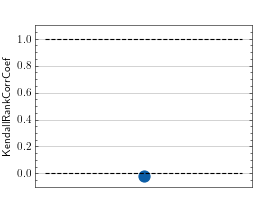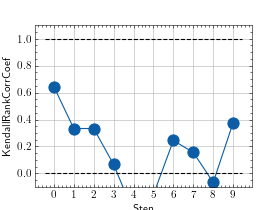Kendall Rank Corr. Coef.¶
Module Interface¶
- class torchmetrics.KendallRankCorrCoef(variant='b', t_test=False, alternative='two-sided', num_outputs=1, **kwargs)[source]¶
Compute Kendall Rank Correlation Coefficient.
\[tau_a = \frac{C - D}{C + D}\]where \(C\) represents concordant pairs, \(D\) stands for discordant pairs.
\[tau_b = \frac{C - D}{\sqrt{(C + D + T_{preds}) * (C + D + T_{target})}}\]where \(C\) represents concordant pairs, \(D\) stands for discordant pairs and \(T\) represents a total number of ties.
\[tau_c = 2 * \frac{C - D}{n^2 * \frac{m - 1}{m}}\]where \(C\) represents concordant pairs, \(D\) stands for discordant pairs, \(n\) is a total number of observations and \(m\) is a
minof unique values inpredsandtargetsequence.Definitions according to Definition according to The Treatment of Ties in Ranking Problems.
As input to
forwardandupdatethe metric accepts the following input:preds(Tensor): Sequence of data in float tensor of either shape(N,)or(N,d)target(Tensor): Sequence of data in float tensor of either shape(N,)or(N,d)
As output of
forwardandcomputethe metric returns the following output:kendall(Tensor): A tensor with the correlation tau statistic, and if it is not None, the p-value of corresponding statistical test.
- Parameters:
variant¶ (
Literal['a','b','c']) – Indication of which variant of Kendall’s tau to be usedalternative¶ (
Optional[Literal['two-sided','less','greater']]) – Alternative hypothesis for t-test. Possible values: - ‘two-sided’: the rank correlation is nonzero - ‘less’: the rank correlation is negative (less than zero) - ‘greater’: the rank correlation is positive (greater than zero)num_outputs¶ (
int) – Number of outputs in multioutput settingkwargs¶ (
Any) – Additional keyword arguments, see Advanced metric settings for more info.
- Raises:
ValueError – If
t_testis not of a type boolValueError – If
t_test=Trueandalternative=None
- Example (single output regression):
>>> from torch import tensor >>> from torchmetrics.regression import KendallRankCorrCoef >>> preds = tensor([2.5, 0.0, 2, 8]) >>> target = tensor([3, -0.5, 2, 1]) >>> kendall = KendallRankCorrCoef() >>> kendall(preds, target) tensor(0.3333)
- Example (multi output regression):
>>> from torchmetrics.regression import KendallRankCorrCoef >>> preds = tensor([[2.5, 0.0], [2, 8]]) >>> target = tensor([[3, -0.5], [2, 1]]) >>> kendall = KendallRankCorrCoef(num_outputs=2) >>> kendall(preds, target) tensor([1., 1.])
- Example (single output regression with t-test):
>>> from torchmetrics.regression import KendallRankCorrCoef >>> preds = tensor([2.5, 0.0, 2, 8]) >>> target = tensor([3, -0.5, 2, 1]) >>> kendall = KendallRankCorrCoef(t_test=True, alternative='two-sided') >>> kendall(preds, target) (tensor(0.3333), tensor(0.4969))
- Example (multi output regression with t-test):
>>> from torchmetrics.regression import KendallRankCorrCoef >>> preds = tensor([[2.5, 0.0], [2, 8]]) >>> target = tensor([[3, -0.5], [2, 1]]) >>> kendall = KendallRankCorrCoef(t_test=True, alternative='two-sided', num_outputs=2) >>> kendall(preds, target) (tensor([1., 1.]), tensor([nan, nan]))
- plot(val=None, ax=None)[source]¶
Plot a single or multiple values from the metric.
- Parameters:
val¶ (
Union[Tensor,Sequence[Tensor],None]) – Either a single result from calling metric.forward or metric.compute or a list of these results. If no value is provided, will automatically call metric.compute and plot that result.ax¶ (
Optional[Axes]) – An matplotlib axis object. If provided will add plot to that axis
- Return type:
- Returns:
Figure and Axes object
- Raises:
ModuleNotFoundError – If matplotlib is not installed
>>> from torch import randn >>> # Example plotting a single value >>> from torchmetrics.regression import KendallRankCorrCoef >>> metric = KendallRankCorrCoef() >>> metric.update(randn(10,), randn(10,)) >>> fig_, ax_ = metric.plot()

>>> from torch import randn >>> # Example plotting multiple values >>> from torchmetrics.regression import KendallRankCorrCoef >>> metric = KendallRankCorrCoef() >>> values = [] >>> for _ in range(10): ... values.append(metric(randn(10,), randn(10,))) >>> fig, ax = metric.plot(values)

Functional Interface¶
- torchmetrics.functional.kendall_rank_corrcoef(preds, target, variant='b', t_test=False, alternative='two-sided')[source]¶
Compute Kendall Rank Correlation Coefficient.
\[tau_a = \frac{C - D}{C + D}\]where \(C\) represents concordant pairs, \(D\) stands for discordant pairs.
\[tau_b = \frac{C - D}{\sqrt{(C + D + T_{preds}) * (C + D + T_{target})}}\]where \(C\) represents concordant pairs, \(D\) stands for discordant pairs and \(T\) represents a total number of ties.
\[tau_c = 2 * \frac{C - D}{n^2 * \frac{m - 1}{m}}\]where \(C\) represents concordant pairs, \(D\) stands for discordant pairs, \(n\) is a total number of observations and \(m\) is a
minof unique values inpredsandtargetsequence.Definitions according to Definition according to The Treatment of Ties in Ranking Problems.
- Parameters:
preds¶ (
Tensor) – Sequence of data of either shape(N,)or(N,d)target¶ (
Tensor) – Sequence of data of either shape(N,)or(N,d)variant¶ (
Literal['a','b','c']) – Indication of which variant of Kendall’s tau to be usedalternative¶ (
Optional[Literal['two-sided','less','greater']]) – Alternative hypothesis for t-test. Possible values: - ‘two-sided’: the rank correlation is nonzero - ‘less’: the rank correlation is negative (less than zero) - ‘greater’: the rank correlation is positive (greater than zero)
- Return type:
- Returns:
Correlation tau statistic (Optional) p-value of corresponding statistical test (asymptotic)
- Raises:
ValueError – If
t_testis not of a type boolValueError – If
t_test=Trueandalternative=None
- Example (single output regression):
>>> from torchmetrics.functional.regression import kendall_rank_corrcoef >>> preds = torch.tensor([2.5, 0.0, 2, 8]) >>> target = torch.tensor([3, -0.5, 2, 1]) >>> kendall_rank_corrcoef(preds, target) tensor(0.3333)
- Example (multi output regression):
>>> from torchmetrics.functional.regression import kendall_rank_corrcoef >>> preds = torch.tensor([[2.5, 0.0], [2, 8]]) >>> target = torch.tensor([[3, -0.5], [2, 1]]) >>> kendall_rank_corrcoef(preds, target) tensor([1., 1.])
- Example (single output regression with t-test)
>>> from torchmetrics.functional.regression import kendall_rank_corrcoef >>> preds = torch.tensor([2.5, 0.0, 2, 8]) >>> target = torch.tensor([3, -0.5, 2, 1]) >>> kendall_rank_corrcoef(preds, target, t_test=True, alternative='two-sided') (tensor(0.3333), tensor(0.4969))
- Example (multi output regression with t-test):
>>> from torchmetrics.functional.regression import kendall_rank_corrcoef >>> preds = torch.tensor([[2.5, 0.0], [2, 8]]) >>> target = torch.tensor([[3, -0.5], [2, 1]]) >>> kendall_rank_corrcoef(preds, target, t_test=True, alternative='two-sided') (tensor([1., 1.]), tensor([nan, nan]))
